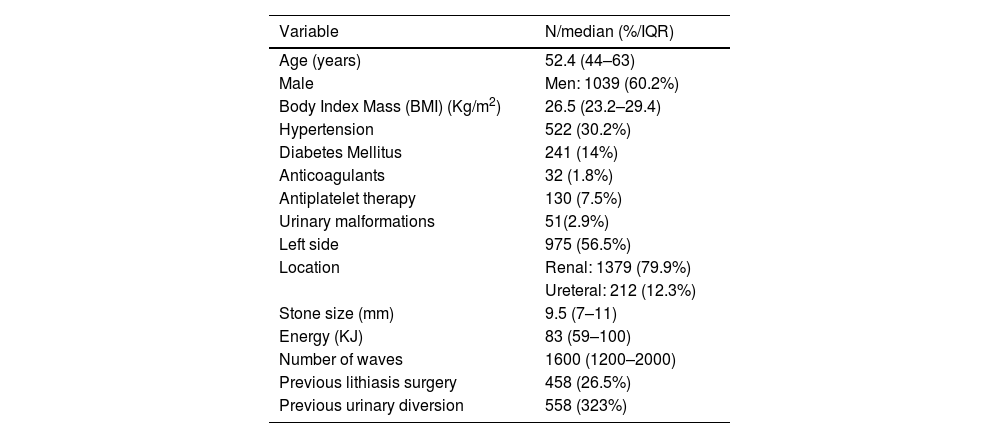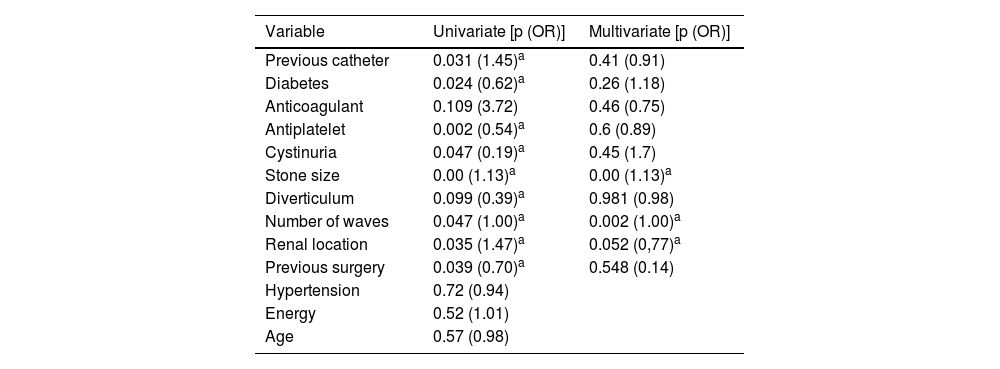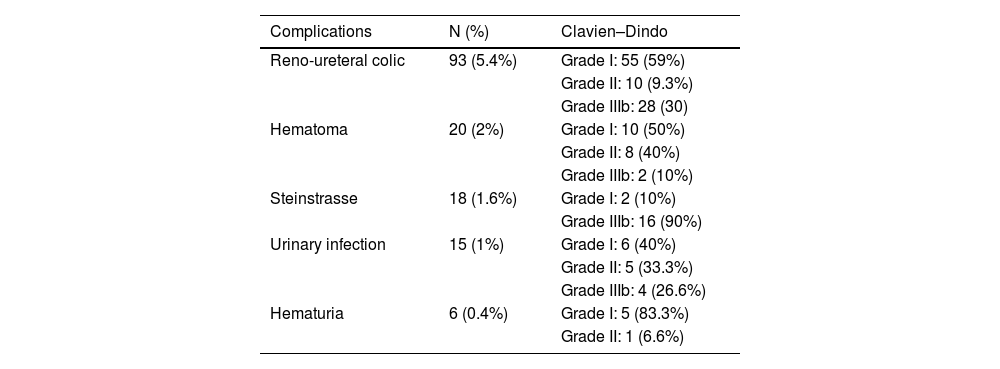To evaluate the efficacy and complications of extracorporeal lithotripsy (SWL) as a first-line treatment for renal and ureteral stones
MethodsRetrospective and observational study of all the patients treated with lithotripsy in a third level center between January 2014 and January 2021; characteristics of the patients, the stones, complications and results of SWL is recollected. Multivariate logistic regression of the factors associated with stone size reduction was performed. A statistical analysis of the factors associated with additional treatment after SWL and factors associated with complications is also executed.
Results1727 patients are included. Stone mean size was 9,5mm. 1540 (89.4%) patients presented reduction in stone size. In multivariate analysis, stone size (OR=1.13; p=0.00), ureteral location of the lithiasis (OR=1.15; p=0.052) and number of waves (p=0.002; OR=1.00) used in SWL are the factors associated with reduction of stone size. Additional treatment after lithotripsy was needed in 665 patients (38.5%). The factors associated with the need for retreatment were stone size (OR=1.131; p=0.000), number of waves (OR=1.000; p=0.000), energy (OR=1.005; p=0.000). 153 patients (8.8%) suffered complications after SWL. A statistically significant association was found between the size of the lithiasis (p=0.024, OR=1.054) and the previous urinary diversion (P=0.004, OR=0.571).
ConclusionLithotripsy remains an effective treatment as the first line of therapy for reno-ureteral lithiasis with a low percentage of complications.
Evaluar la eficacia y complicaciones de la litotricia extracorpórea por ondas de choque (LEOCh) como tratamiento de primera línea de la litiasis renal y ureteral.
MétodosEstudio observacional retrospectivo de todos los pacientes tratados con litotricia en un centro de tercer nivel entre enero de 2014 y enero de 2021. Se recogieron las características de los pacientes, de la litiasis, y las complicaciones y resultados de la LEOCh. Se realizó una regresión logística multivariante de los factores asociados a la reducción del tamaño litiásico. También se llevó a cabo un análisis estadístico de los factores asociados a la necesidad de tratamiento adicional tras la LEOCh y de los factores asociados a las complicaciones.
ResultadosSe incluyeron 1727 pacientes. El tamaño litiásico medio fue de 9,5mm. En 1540 (89,4%) pacientes se observó la reducción del tamaño litiásico. En el análisis multivariante, el tamaño (OR=1,13; p=0,00), la localización de la litiasis en el uréter (OR=1,15; p=0,052) y el número de ondas (p=0,002; OR=1,00) utilizadas en la LEOCh son los factores asociados a la reducción del tamaño litiásico. Un total de 665 pacientes (38,5%) precisaron tratamiento adicional tras la litotricia. Los factores asociados a la necesidad de retratamiento fueron el tamaño litiásico (OR=1,131; p=0,000), el número de ondas (OR=1,000; p=0,000) y la energía administrada (OR=1,005; p=0,000). En 153 pacientes (8,8%) se produjeron complicaciones tras la LEOCh. Se encontró una asociación estadísticamente significativa entre el tamaño de la litiasis (p=0,024; OR=1,054) y la derivación urinaria previa (p=0,004; OR=0,571).
ConclusiónLa litotricia sigue siendo eficaz como tratamiento de primera línea para la litiasis reno-ureteral, con un bajo porcentaje de complicaciones.











